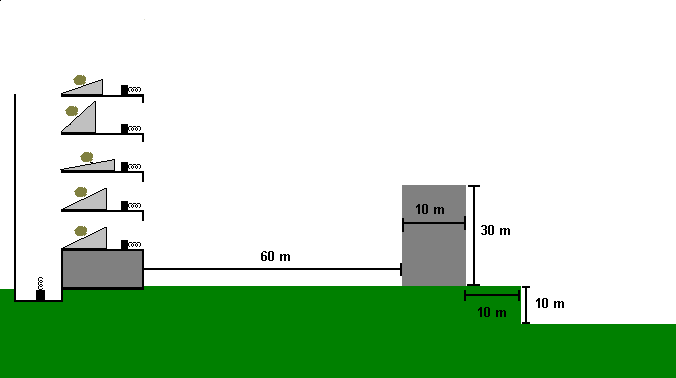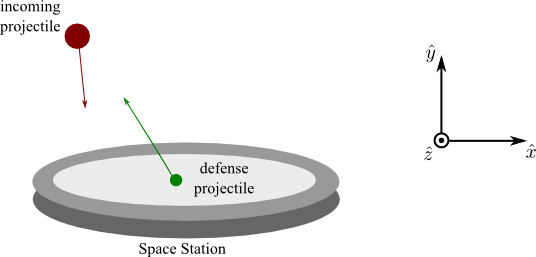Project 12: Part A: Post-Apocalypse Now, Part 2
Project 12A: Learning goals
- For single-particle systems where little or no heat is exchanged with the surroundings, use conservation of energy ($\Delta E_{\rm sys}=W_{\rm ext}$) to explain and/or predict the final state of the system (this includes choosing a system, and setting up initial and final states consistent with that system).
- For multi-particle systems where little or no heat is exchanged with the surroundings, use conservation of energy ($\Delta E_{\rm sys}=W_{\rm ext}$) to explain and/or predict the final state of the system (this includes accounting for the potential energy of each pair of interacting particles; gravitational potential energy).
- This project is predominantly a review of some of the topics covered on Exam 2.
Project 12A: Learning Concepts
- Energy Conservation
- Friction
- Potential Energy
- Kinetic energy
- Constant Force Motion/Kinematics
- Thermal Energy
- Specific Heat Capacity
- Thermal Equilibrium
Stuck in the wilderness for a number of days and unable to contact the people in your bunker, your team along with Willard and Kilgore set out to find a new safe haven. After traversing the scorched wasteland for several days you see postings for “Thunderdome”, which promises “sanctuary for all”. When your team arrives at Thunderdome, you are greeted by the leader of the community Auntie Entity (“Tina” for short), and a 5-story former engineering building with each floor 12 meters high. Your team is told that you all can become community members if you can design a defense system based on a bow design that the community has been working on. The defense system consists of a support anchored to the floor to hold a horizontally aligned spring-loaded harpoon launcher in place. There is a defense system in place on floors 2 through 5, as well as the roof.
In addition to vicious boar tigers, zombies have begun to overrun other settlements in the area and Auntie wants to be prepared for their imminent arrival.
They request some specifics for the machine and indicate some constraints:
- There is an ample supply of 3 kg harpoons.
- The harpoons can only be fired horizontally but must have the greatest variation in range possible.
- It must fire carbon steel harpoons at or below 270 K (it has been found that cooled projectiles have a greater effect on zombies)
- Initial tests suggest that to penetrate zombie flesh, harpoons must have a speed of at least 200 m/s.
The engineering building is 60m from a solid, concrete defensive wall of height 30m and thickness 10m surrounding the Thunderdome. Beyond the wall is a 10m horizontal flat ledge followed by a plain that is 10m below ground level to capture the zombie hoards. Inside the building is an abandoned elevator shaft that extends from the ground floor to the roof. The layout of the engineering building and its surroundings is depicted above.
You are also supplied with the following materials:
- A spring with a lock mechanism that enables it to be locked at various compressions with a spring constant of (15000 N/m). There is no crank strong enough to compress this stiff spring.
- On each floor of the engineering building is one defender, an anchored harpoon launcher support, a harpoon launcher, and one concrete block of mass 400kg resting on an adjustable, steel inclined plane adjacent to the elevator shaft.
- You can also request an amount of ice (at $250\,{\rm K}$) but you have to be specific as supplies are low.
The spring-loaded harpoon launchers are detachable and can easily be moved from floor to floor, or to the bottom of the elevator shaft. The plan is to drop the concrete blocks down the elevator shaft onto the spring to compress the spring. Design the defense system to find the minimum angle for the boulder to fall down the elevator shaft and the range/locations outside the defensive wall that your system can reach with the required specifications. Indicate your supply needs to meet Aunty Entity's requirements to keep Thunderdome safe.
Post-Solution questions:
- A 90 kg zombie is moving 1 m/s directly toward Thunderdome. If a harpoon launched with the maximum possible velocity strikes this zombie and embeds in the zombie’s flesh, what is the velocity of the zombie immediately after being struck with the harpoon?
- Willard suggests you can increase the range of the harpoons if the harpoon launcher is not anchored to the floor, and thereby would recoil. Would this work? Use the lowest workable launch speed to confirm your prediction. What is the new launch speed, and what is the recoil speed of the launcher/support? The anchor and spring launcher have a mass of 400 kg (excluding the harpoon).
- Draw a free-body diagram of the harpoon launcher as it slides along the concrete floor. What is the frictional force acting on the launcher during this slide, and using forces how far does it slide. After all, you don’t want it to fall into the elevator shaft.
- Sketch the trajectory of one of the launched harpoons. For a point halfway from where it is launched to where it strikes a zombie, draw a free-body diagram showing all forces acting on the harpoon. In the past when objects were in freefall, we used a vertical-horizontal coordinate system. Here, we'd like to investigate what the parallel and perpendicular components of the net force look like, and how they affect the motion. With this in mind, sketch the parallel and perpendicular components of the net force acting on the arrow.
We can use the momentum principle to express the net force as: $$\vec{F}_{net}=\frac{d\vec{p}}{dt}=\frac{d\mid\vec{p}\mid}{dt}\hat{p} + \frac{d\hat{p}}{dt}\mid\vec{p}\mid$$
- Which term is the parallel component of the net force, and which term is the perpendicular component of the net force?
- Which component causes the direction of the momentum to change, and which component causes its magnitude to change?
Project 12, Part B: Saving a probe
Project 12B: Learning Concepts
- Judicious choice of system
- Recognizing boundaries of a collision
- Momentum conservation
- Energy conservation
- Using graphs to explain/understand phenomena
Questions to test pre-reading:
- What is an elastic collision? What is conserved in this type of collision?
- What is an inelastic collision? What is conserved in this type of collision?
- What is a maximally inelastic collision? How does this differ from the more general inelastic collision?
You are trying to recover HAL. HAL, if you remember, was a part of the satellite ($m_{\rm t}=4500\,{\rm kg}$) that the Carver Media Group Network (CMGN) launched. The satellite (and HAL) was designed to communicate with Earth out to a distance of 3.8 million kilometers. As part of the electronics HAL contains a green and a red light-emitting diode (LED) mounted on the outer surface of the satellite. One of the probes ($m_{\rm p}=400\,{\rm kg}$) remains attached to a single, very stiff spring ($k_{\rm p}=5.3\times10^{9}{\rm N/m}$) that can be compressed remotely and then released to fire off the probe. You have hacked into this remote firing mechanism.
Unfortunately, a transcription error was made by Mr. Stamper, Carver's chief “engineer” when the satellite was initially launched. As a result, the satellite escaped Earth's gravity and is currently traveling in a straight line away from the Earth at a distance of 1.9 million kilometers. Its speed is nearly constant at $340\,{\rm m/s}$. The gyroscope system that keeps the orientation of the satellite constant is still working. However, an asteroid ($m_{\rm a}=9300\,{\rm kg}$) traveling at a speed of $950\,{\rm m/s}$ is on a direct collision course (in line with the Earth and HAL) and the collision is imminent. The asteroid is presently 500 kilometers from the satellite.
Your team can recapture the satellite if it can be returned to Earth. You should design a way to return the satellite to Earth. You will also need to ensure the asteroid will not collide with the satellite - damaging the probe is ok. Your team also needs to determine the minimum amount of time until the possible collision to determine if communication from Earth can be completed in time.
Project 12: Part C: Saving a space station
The satellite with HAL is on it's way back to Earth but behind the satellite is a number of small asteroids. A member of the recovery team, David Lightman, tells you that there is a defunct Earth defense floating space station that is very far from Earth which can be hacked into. You have been tasked with operating this projectile defense system (PDS for short). PDS has the ability to launch defense projectiles from the space station headquarters (positioned at the center of the space station) to divert incoming attack projectiles (asteroids heading for Earth).
- The mass of a defense projectile is about $20\,{\rm kg}$, made out of sticky Space Clay™.
- The average mass of an attack projectile is about $5$ times that of a defense projectile, usually made of a solid metallic material.
Before the first firing of a projectile from the defense system, your boss would like to see a properly functioning simulation showing how the incoming attack projectile's motion can be changed by the defense projectile to be sure that you can be trusted with the PDS. The code is mostly functioning in its simulation of before and after an interception (collision) for a worst-case scenario: an attack projectile being launched directly towards headquarters at its largest ever recorded velocity $\langle 225,-400,0 \rangle\,{\rm m/s}$ from its closest-ever recorded position $\langle -500,900,0 \rangle\,{\rm m}$. For this worst-case scenario defense to be successful, you must push the incoming attack projectile back along its incoming path so that its velocity is $\langle -450,800,0 \rangle\,{\rm m/s}$. However, it still has a couple of issues that need to be corrected:
- There is an issue with the line of code where the initial velocity of the defense projectile launched by PDS is calculated.
- The Department of Projectile Energy (DoPE) for the Thunderdome, your home base, would like a report on the loss of kinetic energy during the collision as it is interested in further harnessing the power of the PDS once this asteroid problem is over. There is an energy graph in place, but for some reason, it is indicating no energy is lost in the collision.
https://www.glowscript.org/#/user/pcubed/folder/incompleteprograms/program/SavingStationb


